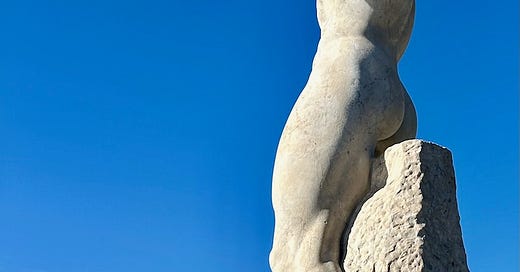Gillian Knows Best guide to the Foro Italico + Rome’s Olympic history
Gleaming marble with a dark past

Are you watching the Olympics in Paris? Does it make you anxious? Or inspired? How about that bewildering and staggering opening ceremony!
The winter games have been in Italy three times and the next winter games are happening in Milan and Cortina d'Ampezzo in early 2026. Summer games have only been held in Italy one time. The 1960 Summer Olympics in Rome.
The main site where most of the competition took place was built in the late 1950s in and around the existing Foro Italico that Mussolini had built in the early 1930s. New venues and city infrastructure were constructed mostly in the area just beyond the via Flaminia not far from Piazza del Popolo and Villa Borghese. Places designed by Pier Luigi Nervi like the Palazzetto dello Sport (one of my favorite buildings in Rome) and the Corso di Francia Viaduct (an iconic Roman site you are unlikely to see unless you are shuttling kids to fancy private schools in Roma Nord.) The city also made use of some things they already had around. There was wrestling in the Basilica of Maxentius, gymnastics in the Terme di Caracalla and a marathon along the via Appia.
If you love the clean straight lines of EUR or the Richard Meier building where the Ara Pacis lives then make room in your travel plans for a visit to this part of town.
It took me leaving Rome to finally visit the Stadio Olimpio. I had gotten close plenty of times, but somehow I never set foot inside. Our first Christmas in Italy we bought our tree in the parking lot next door. I have sent teenagers to concerts there and driven past the obelisk carved with the words Mussolini Dux on countless school runs. Crossing the Ponte Flaminio - Corso di Francia bridge is where I truly understood the power that architecture could project. Our best friends lived in the Villaggio Olimpico for a few years.
I visited on one of those last of the bluebird winter days when the sun feels good and the air sparkles. When the massive marble sculptures are impossibly white against that only in Rome blue sky, belying the dark history that created this space.
The guiding idea behind the Foro Italico Complex was to educate young people by combining sports and fascist ideals. The Viale del Foro Italico is inlaid with striking black and white mosaics designed by Gino Severini. Even though I had seen the Mussolini obelisk so many times that it was almost background noise, I found the aggressively Fascist messages and motifs in the mosaics shocking. Here is a fun fact. Cycling is one of the sports that isn't depicted anywhere in the complex. Mussolini considered cycling a communist sport
This is also where the most Instagrammed swimming pool in Rome is. The one with the walls covered in massive glass mosaics of men with perfect muscles. Artists from the Mosaic School of Fruili Spilimbergo created the majestic space.
This area of Rome is a feast for the mid-century and modern architecture fan. The Villagio Olimpico was built as housing for the 1960 athletes. Now it is residential neighborhood. The Renzo Piano designed Auditorium complex has multiple concert venues and hosts classical and pop music as well as dance and film events. The bookstore is also great. Peek through the condominium gates on the Viale del Vignola at the row of pastel houses with front steps that is known as Piccola Londra.
Span the centuries and combine a visit to the Stadio Olimpico with some contemporary art at the Maxxi and some ancient art at the Museo Nazionale Etrusco di Villa Giulia. The Ponte Milvio was built in 206 BC. It is also where the Roman Emperors Constantine I and Maxentius fought over the control of the Roman Empire.
How to get to the Stadio Olimpico
It is a little challenging to get to and from this part of town. I usually take a taxi. You can take the number 2 tram (Because of Jubilee preparations and general Rome being Rome for now it is a bus and not a tram) from just outside the gates at Piazza del Popolo all the way to the end to Piazza Mancini and walk from there.
Where to eat near the Stadio Olimpico
The Ponte Milvio neighborhood has lots of places to eat and drink. La Pallotta was a family favorite but it has been a very long time since we have been. Lo'steria has great Roman classics and is a good bet for a plate of amatriciana and cicoria and a bottle of Cesanese. For something quick there is a Trappizzino or get a drink and a pastry at the historic Pasticceria Mondi. On the via Flaminia is 20MQ, a cafe and boutique where you can get smoothies, grain bowls and bagel sandwiches. Neve di Latte, one of Rome’s best gelaterias, has a shop just outside of the Maxxi Museum.









Love this-- a completely new neighborhood to explore. The Fascist era architecture is fascinating to me. Aesthetically, I can appreciate it, but my initial emotional response is always to recoil a little. And the idea that Mussolini found cycling to be a communist activity cracked me up...
As always, so well written. Thank you for sharing this neighborhood and history with us!